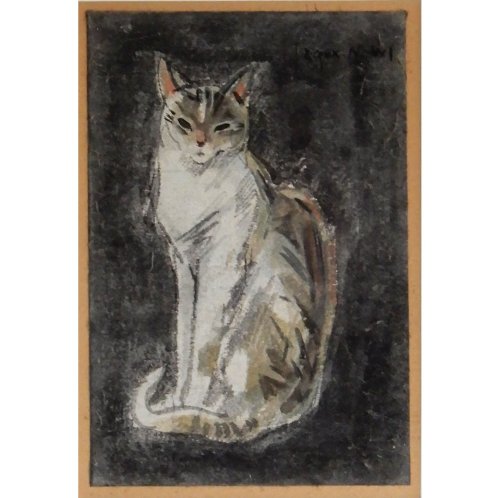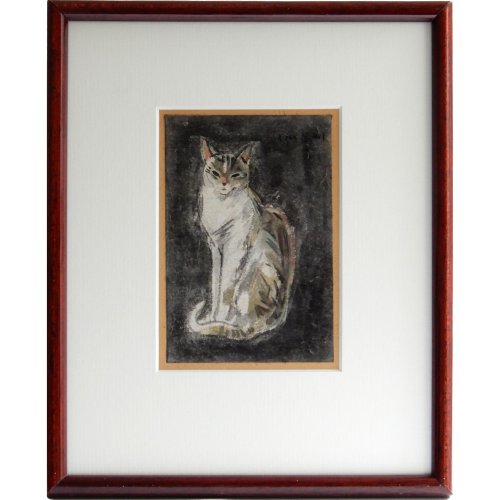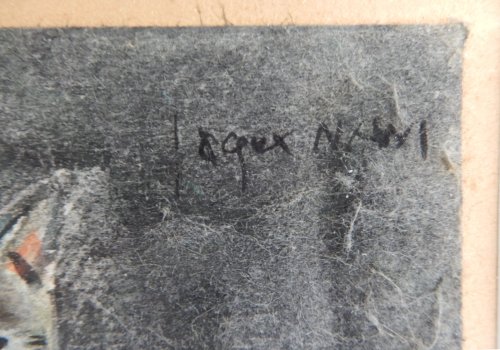Jacques Nam (Lehmann) (1881-1974) Sitting Cat
About this piece
"Charming portrait of a tabby sitting cat. She appears to be enjoying the sunshine or gently squinting her eyes to greet her owner.
It's a small watercolour gifted by Jacques Nam in the 1950s to one of his students. The black background enhances the beauty of the cat.
The paper seems to be handmade, with a somewhat woolly texture. The watercolour is signed in the top right corner by 'Jacques Nam'."
Biography:
Jacques Nam, born Jacques Lehmann, (Paris, 1881-1974) was an illustrator, painter and sculptor.
He
was best known for his portraits of animals, he had a great passion for
cats. In addition to his many works of art in which cats and other
animals were central, he also painted portraits, nudes and landscapes.
He has also worked as an illustrator for various magazines and
newspapers, he designed posters as well.
Jacques Nam grew up in a
very musical family, he already had a huge passion for cats as a child
and drew them a lot. His talent was noticed and he went to the art
academy in Paris (École des Beaux-Arts), he was a student of Jean-Léon
Gérôme. He also worked as an illustrator at the time. In addition, his
love for animals was so great that he specialized in them, he often
visited the Jardin des Plantes to study the animals. He was especially
interested in the felines, but also exotic animals and large predators
had his interest.
He soon had success. His style of painting was
very stylized and decorative, his work is therefore very representative
of the Art Deco. He won a gold medal at the World Exhibition
(l'Exposition des Arts décoratifs et Industriels moderne) in 1925. In
1926 he was awarded with the Chevalier de la legion d'Honneur.
Besides painting and drawing, Jacques Nam also made lacquer works, a
very difficult and labour-intensive technique that just a few artists
mastered.
The Japanese lacquer artist Seizo Sugawara who came to
Paris around 1910 taught this technique to a number of artists,
including Eileen Gray and Jean Dunand, to name a few of his most famous
students. The paintwork became a very exclusive art. Jacques Nam has
made several panels, almost always with an animal in the lead. Several
panels are known that have the same structure as this panel with the
polar bear, the black lacquer with the image and the gold leaf around
it. The animal is depicted in a deepened relief. He also made large
folding screens with lacquer. Nam's work was already collected by the
major collectors.
His illustration of books also took up a large
part of Jacques Nam's oeuvre. For example, he worked with Colette, with
whom he was good friends. He made the illustrations for 'Sept dialogues
de bêtes' in 1912, together with André Demaison and Claude Ferrère.
Nam
was also a sculptor, poet and musician. Many of his cat sculptures are
made in porcelain at Manufacture de Sèvres, his bronzes are also still
in demand and are reminiscent of the works of the sculptor Sandoz in
style.
Jacques Nam died at the age of 92 in his Paris apartment.
His
work can be seen in various museums including Musée Poulain in Vernon
and Musée La Piscine in Roubaix. His work is still highly sought after
and is also included in several major private collections worldwide.
Literature:
- ‘Wat is art
nouveau & art deco waard', deel I&II, redactie Rob Zeegers Janny
Stuurman-Aalbers en Reinold Stuurman, Uitgeverij Scriptum Art ,
Schiedam, NL en Snoeck-Ducaju & Zoon, Gent, België, 2001. Part I,
p.288.
- Thierry Roche; 'Dictionnaire biographique des sculpteurs des années 1920-30', Édition Beau-Fixe, 2007. P.322.
- Emmanuel Bénézit: Dictionnaire critique et documentaire des peintres, sculpteurs,
dessinateurs et graveurs de tous les temps et de tous les pays. Édition Gründ, Paris,1999. Volume 8, p.456.
Condition
Very good. We have provided the artwork with Art-glass (museum glass) and a new acid-free backside and a passe-partout.
Material:
Paper, aquarel
Measurements:
Watercolour::
Length: 14,5 cm
(5,71")
Width: 9,5 cm
(3,74")
Framed:
Length: 29,5 cm
(11,61")
Width: 24 cm
(9,45")
Period:
Before 1955
Origin:
France
Artist / atelier:
Jacques Nam (Lehmann),





